The Ultimate Guide of the Giant’s Causeway
The Giants Causeway in County Antrim, Northern Ireland, located on the stunning north coast, is a unique natural wonder and one of the highlights of Northern Ireland. This amazing place offers breathtaking views, a dramatic coastline, and photogenic landscapes that evoke a sense of wonder and adventure. It is a breathtaking sight just 9 miles along the Causeway Coastal Route from Portrush.
The Unesco World Heritage Site is situated near Bushmills on the Antrim Coast in Northern Ireland. It is regarded as one of Ireland’s and Northern Ireland’s most significant natural wonders, attracting visitors from across the globe. For many tourists visiting Belfast and Northern Ireland, a tour of the Giant’s Causeway is a highly anticipated experience.
The Antrim Causeway Road is known for its stunning landscapes and is a popular destination for those interested in Game of Thrones and legends of the Giant’s Causeway. Visitors can enjoy walking the Carrick-a-Rede rope bridge, exploring the romantic ruins of Dunluce Castle, and visiting charming villages and towns in Northern Ireland. Additionally, Belfast offers a unique experience, including celebrating Christmas.
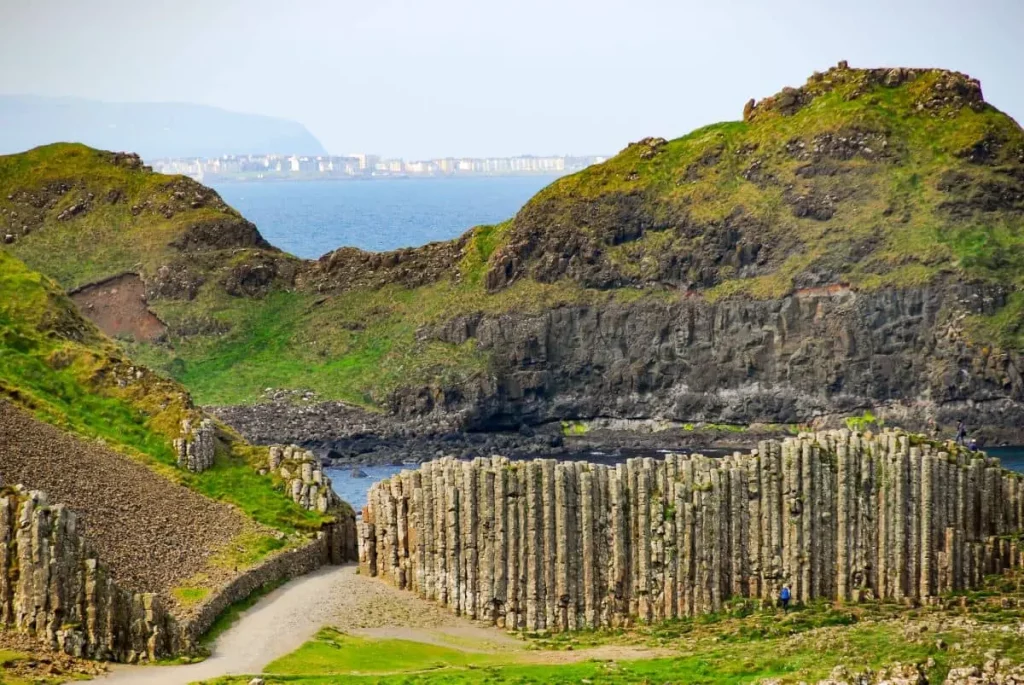
Facts and history of the Causeway.
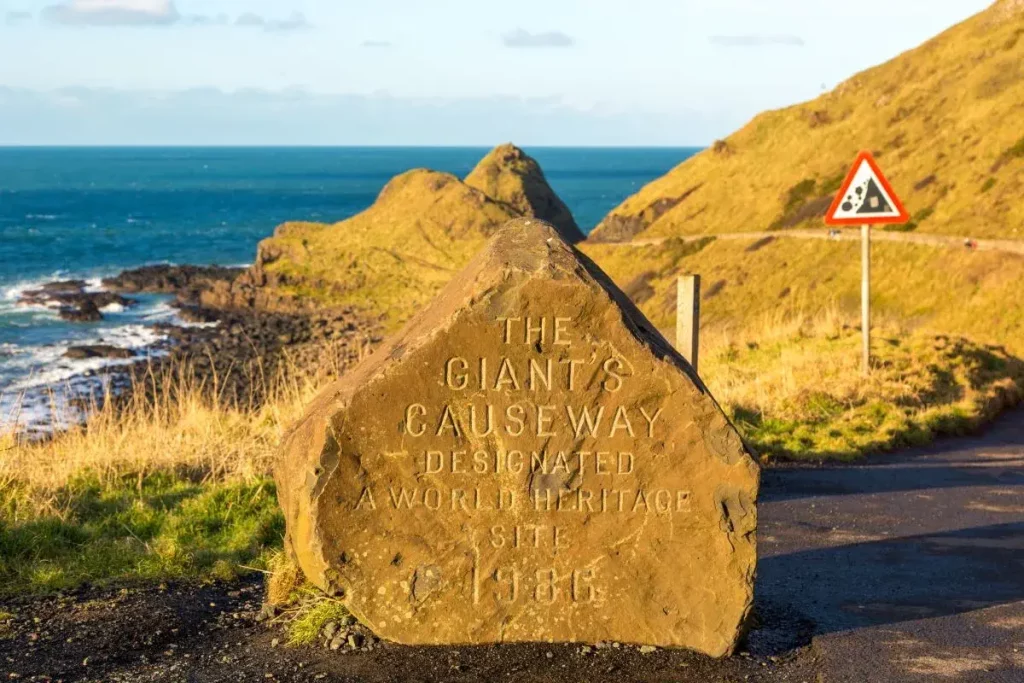
The Unesco World heritage Site?
The Giant’s Causeway and the Causeway Coast in Northern Ireland is recognized as a UNESCO World Heritage Site and is considered a remarkable area of global geological significance. Each year, more than a million visitors come to witness this natural wonder on a Tour or at one of the visitor centre’s exhibition
The Causeway Stones are a promontory on the Causeway Coast comprised of interconnected polygonal basalt columns formed by volcanic activity. These basalt rock columns are a unique geological feature, created when volcanic lava cooled rapidly, resulting in the distinctive shapes seen today. This section of the Antrim Coast boasts over 40,000 basalt Columns, these weathered rock formations were formed about 60 million years ago

How was the Giant’s Causeway formed?
The Causeway was formed around 50 to 60 million years ago during intense volcanic eruptions. The molten basalt lava that was thrown up through Antrim’s chalk beds formed a lake of lava. As the lava cooled and contracted, cracks formed the neatly packed columns of hexagonal stones and pillars that we see today, which are known as the 8th Wonder of the World.
Hexagonal patterns, similar to those seen at the Giant’s Causeway, can be found across the world, including locations such as the Devil’s Postpile in the US, Fingal’s Cave on the Isle of Staffa in Scotland, Swartifoss Waterfall in Iceland, and Los Prismas Basálticos in Mexico, among others.
See here for a great article on other places as spectacular as the World Heritage Site
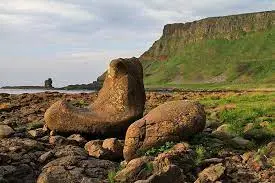
In addition to the scientific explanation, Irish folklore offers a mythical perspective, with local legends involving giants like Finn MacCool playing a key role in the story of the Causeway’s creation.
Giants Causeway Legend
In ancient times, there was an Irish giant Finn McCool, or Fionn Mac Cumhaill in Irish, who lived in Ireland. He was known for being 54 feet tall and possessing incredible strength. Finn was married to Oonagh and resided on the Antrim Coast.
Over on a Scottish Island, there was a giant named Benandonner who considered himself to be the strongest giant in the world. He would antagonize and taunt Finn from across the waters. One day, Finn became extremely angry and threw a chunk of earth at him. Unfortunately, the chunk missed and fell into the Irish Sea, forming the Isle of Man. The hole created by the earth chunk became known as Lough Neagh.
Both Finn and Benandonner built causeways to connect Scotland and Ireland, with each giant working for weeks on their respective paths.
Finn and Benandonner met at the paths’ intersection. Finn was surprised by the enormous size of the Scottish giant. Benandonner hadn’t noticed Finn yet, so, in a hurry, Benandonner went back home seeking Oonagh’s assistance. Oonagh, being clever, disguised Finn as a baby and placed him in a large cradle. When Benandonner knocked on the door, Finn pretended that the baby was crying. Seeing the “baby,” Benandonner wondered how massive the Irish Giant Fionn must be if the baby was that huge. Filled with fear, Benandonner quickly returned home, destroying the causeway behind him so Finn couldn’t pursue him.
Where is the Giant’s Causeway?
The Giant’s Causeway is located on the Antrim Coastal Route, just a 15-minute drive from the village of Bushmills Portrush near. It is also in close proximity to Dunluce Castle and the Carrick-a-rede rope bridge, approximately 10 and 15 minutes away, respectively. Dunseverick Castle is another nearby historical attraction, and it serves as a starting point for scenic walks to the Giant’s Causeway. The Causeway Coast has been a popular filming location for Game of Thrones and there are several pubs and restaurants along the route that display the carved tours from the fallen trees in the Dark Hedges.
Visitors can also use the Dundarave Car Park in Bushmills, which offers a convenient Park and Ride service to the Giant’s Causeway. Bushmills Park is another Park & Ride service location near Bushmills, providing additional parking and transit options for visitors.
What is a Giants Causeway tour?
A Giants Causeway Tour is a guided excursion that takes visitors to one of Northern Ireland’s popular attractions, the Giants Causeway. The tour usually includes transportation from Belfast or Dublin, a knowledgeable tour guide, and stops along the Causeway Coastal Route such as Dunluce Castle, the Carrick-a-Rede Rope Bridge, and notable attractions like the Old Bushmills Distillery and Bushmill’s Distillery. These distilleries are often featured in tour itineraries, offering visitors a chance to experience local whiskey heritage. The tour also provides an opportunity to explore the unique basalt columns of the Giants Causeway.
Be sure to visit Giant’s Causeway as part of a comprehensive tour experience to make the most of your trip.
Tour the Giant’s Causeway from Belfast
If you want to go to the Giants Causeway from Belfast City and have rented a car, it is an easy drive. Visitors should note that driving in Northern Ireland is on the left side of the road, so be sure you are comfortable with this before renting a car. The distance is around 51 miles and it takes about an hour and a half. Alternatively, visitors can use Translink’s local bus services from Belfast to Bushmills, making the journey to the Giant’s Causeway hassle-free. You can park at the Giant’s Causeway Railway Park near Bushmills Village. The tram ride to the Causeway takes 20 minutes. If you take the tram, parking is free and the ticket prices are £5.00 for adults and £3.00 for children.
Visitors have the option to park at the Giant’s Causeway Railway park for a fee of £6.00 per car per day. From there, they can easily walk to the stones without any additional cost.
What is the best time to book a Giants Causeway tour?
The recommended time to book a Giants Causeway tour is during the summer months of June through August when the weather is usually warmer and drier. It is advised to book in advance due to the high demand during this time.
Alternatively, visiting during the shoulder season—spring or fall—can be a great option to avoid crowds and still enjoy pleasant weather.
What is the Causeway Coastal Route?
The Causeway Coastal Route is a scenic roadway located along the northern coast of Northern Ireland. The route features various attractions, including the Dark Hedges, Dunluce Castle, and the Giants Causeway.
What other attractions are typically included in a Giants Causeway tour?
Along the Causeway Coastal Route, popular attractions such as Dunluce Castle, Carrickfergus Castle, the Carrick-a-Rede Rope Bridge, and the Bushmills Distillery are often included in most tours, in addition to the Giants Causeway.
How long does a Giants Causeway tour typically last?
A typical Giants Causeway tour typically lasts between 1 to 3 hours, with many tours lasting about two hours depending on the itinerary and pace. The exact duration can vary based on the tour company, itinerary, any additional stops, and how fit you are, as there are long steep walking trails such as the Blue Trail.
Are there Giants Causeway guided tours?
When you go on a pre-booked tour, all Giants Causeway tours are led by an experienced tour guide who will provide information about the attraction, the surrounding area, and answer any questions you may have. Visitor experience tickets include guided tours, access to the Visitor Centre, and various facilities aimed at enhancing visitors’ enjoyment of their time at the Giant’s Causeway. For accessibility, mobility scooters and wheelchairs are available on a first come, first served basis.
There are also audio guides included in the visitor experience ticket price. These use hand held audio guides from the national trust award winning storytelling team, so visitor experience ticket holders can enjoy a guided tour of the visitor’s centre, world heritage site and the four walking trails at their own pace. We highly recommend the Blue trail for discovering some spectacular views of Northern Ireland’s visitor experience.
What is the cost of a Giants Causeway tour?
The cost of a guided Giants Causeway tour varies depending on factors such as the tour company, itinerary, and additional stops. Prices start at £25 per person for a basic bus tour, with prices generally ranging up to £100 to £300 per person for more luxurious or private tours along the county antrim stepping stones.
Full details of tours can be found here
As part of the visitor experience entrance price you can pick up an audio guide at the rear entrance to the Visitor’s centre. They are available in many languages
Giant’s Causeway Tour from Belfast
Experience the UNESCO World Heritage-listed Giant’s Causeway on a full-day trip from Belfast. With the guidance of a knowledgeable tour guide, journey through the stunning countryside of Northern Ireland by luxury coach. Finally, reach the Giant’s Causeway and marvel at the breathtaking scenery.
Day Tour from Dublin to the Giant’s Causeway
The drive from Dublin, Ireland to the Giant’s Causeway takes approximately 3 hours. Additionally, there are various tours available from Dublin that allow you to explore the Causeway Coast.
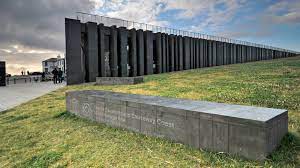
The Giant’s Causeway Visitor Centre
In 1986, a visitor center was opened to coincide with its addition to the list of Unesco world heritage sites. Unfortunately, it was damaged by a fire in 2000. However, a new state-of-the-art, award-winning visitor center was built and opened in July 2012. The visitor center is the main facility for information, services, and amenities for tourists. The opening hours of the visitor center typically run from around 09:00 to 17:00, while parking remains open all day. Toilet facilities are available at the visitor center, as there are no toilets on the Causeway itself.
Is there a fee to see the Giant’s Causeway or is there a way to visit for free? The Giant’s Causeway is free to visit and there is a charge for the car park at the Causeway visitor center, which provides parking and access to the center, not the Causeway itself. You can also use the Car Park at the Giants Causeway Railway for £5 and walk the 50m or so up the hill when you visit giant’s causeway.

We would recommend using a car park as the police are notorious for issuing tickets on the Causeway Road which would put a damper on your visitor experience.
How much does it cost to go to the Giants Causeway? If you wish to use the visitor center and its parking you will be charged per Adult £13.50, and per Child £6.75.
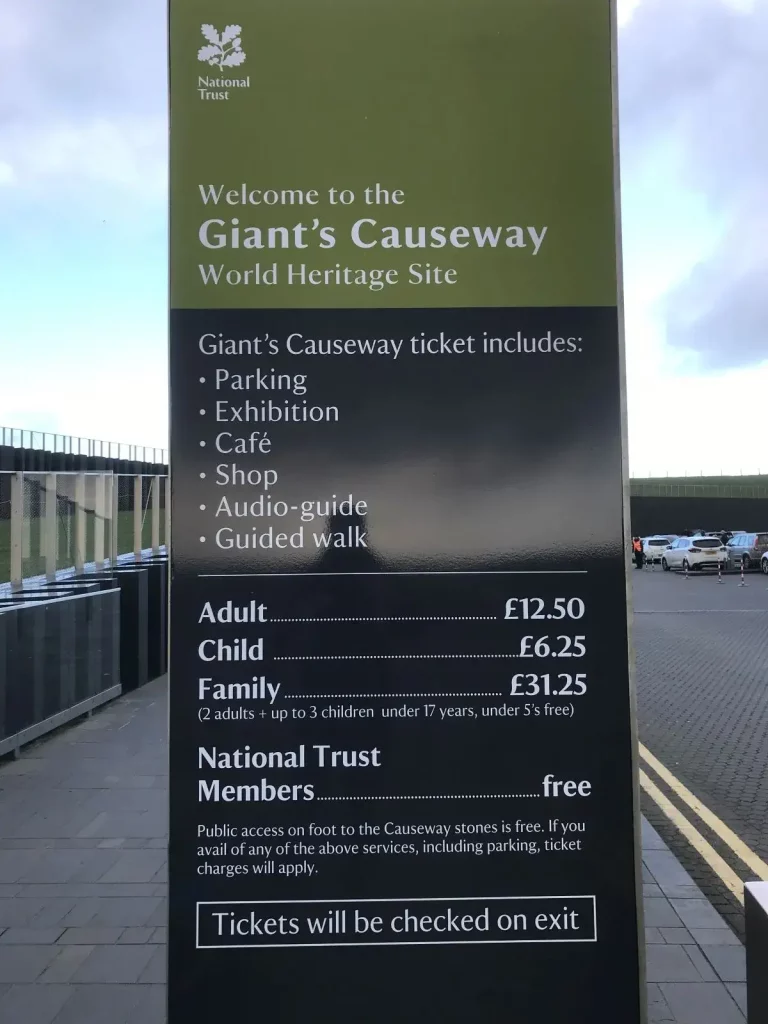
Accommodation near the Giant’s Causeway
When planning your visit to the Giant’s Causeway, you’ll find a wide variety of accommodation options to suit every taste and budget. The iconic Causeway Hotel sits right next to the Giant’s Causeway Visitor Centre, offering guests unbeatable access to the UNESCO World Heritage Site and breathtaking views of the Atlantic Ocean. For those seeking a more homely experience, there are charming Bed & Breakfasts, holiday cottages, and self-catering apartments in nearby towns such as Bushmills, Ballycastle, Portballintrae, Ballintoy, Portrush, and Portstewart. These locations provide a perfect base for exploring the causeway and the wider Causeway Coast.
If you prefer the buzz of city life, both Belfast and Derry are within easy reach by car or public transport, and offer a broader range of hotels and guesthouses. No matter where you choose to stay, booking your accommodation in advance is highly recommended, especially during peak season, to ensure you get the best spot for your visit to one of Northern Ireland’s most famous sites. Whether you’re waking up to the sound of the Atlantic or relaxing after a day of exploring, staying near the Giant’s Causeway makes your trip to this world heritage site even more memorable.
How to get into Giants Causeway for free
The National Trust Giant’s Causeway visitor centre is located approximately one mile away from the Causeway itself, and is not directly connected to it. Some visitors may mistakenly believe that parking and paying at the visitor centre is the only way to access the Causeway. It is advisable to consider alternative options as the visitor centre may not fully benefit the local community and the admission fee for seeing the Causeway may be considered excessive.
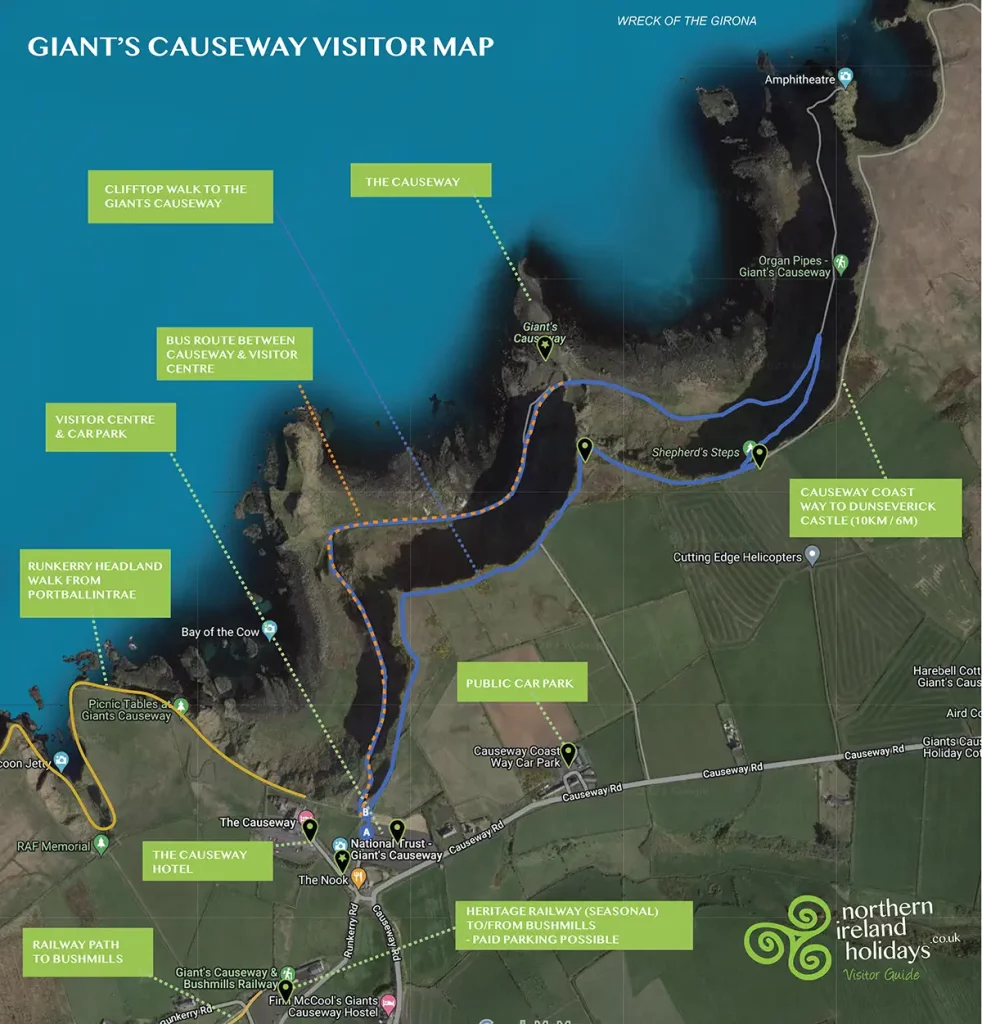
The cost of parking at the Visitors Centre is an extortionate £13.50 per person and 6.75 per child in the vehicle so it isn’t a one-off fee per car.
Hikers have the option to start at Portballintrae and the route can be walked along the coast to the Causeway, which runs alongside the tram line and Bushfoot Golf Club. You can also walk along the side of the train tracks from Bushmills. When walking near the water’s edge, exercise caution as rocks can be slippery and tides may change quickly.

Visitors can also experience the hospitality of The Nook pub, conveniently located beside the Causeway. If requested, parking is available free of charge. We had a delightful lunch at the pub and enjoyed the cozy atmosphere of the open fire before taking a leisurely walk to the Causeway. From The Nook, it is a brief stroll to the tunnel behind the visitor’s centre, where a bus can be caught to reach the Causeway.
The final option, although not strictly free, is to buy a national trust membership. This will get you in for free along with other national trust sites such as Mussenden Temple, Portstewart Strand and more along the county antrim coast.
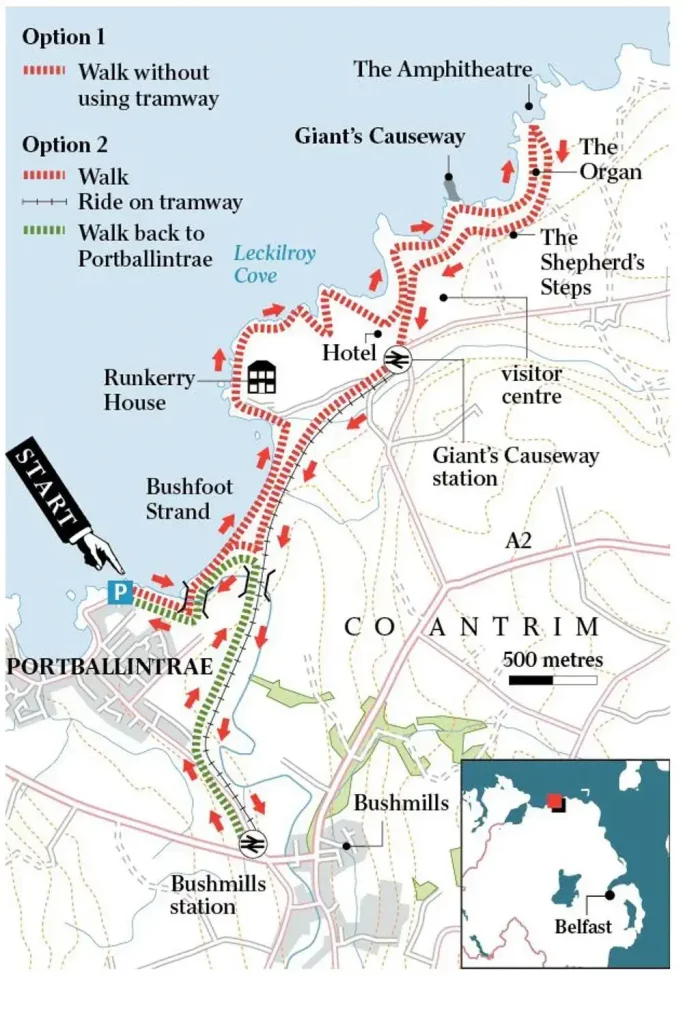
How long does it take to see the Giant’s Causeway?
The average time to explore the Giant’s Causeway is approximately 2-3 hours. To save energy, you can take the small bus located behind the Visitor’s Center after the tunnel. The bus fare is £1 for a roundtrip down to the Coast and back up.
Giant’s Causeway Weather
It is recommended to visit the Giant’s Causeway during the summer season, either early to late spring or early to late fall, in order to avoid crowds and experience pleasant weather. However, due to the location the weather can be changable and often windy. We have visited many times where its warm and sunny at the visitor’s centre thenonce you get passed hamilton’s seat the wind chills you to the bone. Many have been found sheltering from the wind beneath the chimney stacks or at the interpretation area
Trails and Paths at the Giant’s Causeway
Exploring the Giant’s Causeway is a true adventure, thanks to its network of scenic trails and paths that showcase the best of Northern Ireland’s north coast. The Blue Trail is a favourite for many visitors, offering a gentle, paved route that leads directly from the visitor centre down to the famous basalt rock formations. For those seeking a bit more of a challenge and even more stunning views, the Red Trail follows the dramatic cliff tops above the causeway before descending 162 steps to the rocks below. This route rewards walkers with panoramic vistas of the Atlantic Ocean and the rugged coastline.
For keen hikers, the Giant’s Causeway is also a highlight of the Causeway Coast Way, a long-distance trail that winds along the coast, connecting some of Ireland’s most spectacular landscapes. Whether you choose to walk at your own pace, join a guided tour, or simply take in the sights from the cliff tops, the trails at the Giant’s Causeway offer something for everyone. Don’t forget your camera—every turn reveals new perspectives on the unique rock formations and the wild beauty of the coast.
What to see at the Giant’s Causeway
The Giant’s Causeway Coast route offers various hiking and walking options, including four trails within the site suitable for all abilities and ages. As you continue through the tunnel, follow the roadway down the steep slope until you reach the Stookans or Windy Gap, which is completely exposed to the elements.
The Giant’s Causeway consists of three sections: Little Causeway, Middle Causeway (also known as the Honeycomb), where visitors can observe the impressive black basalt hexagonal columns.
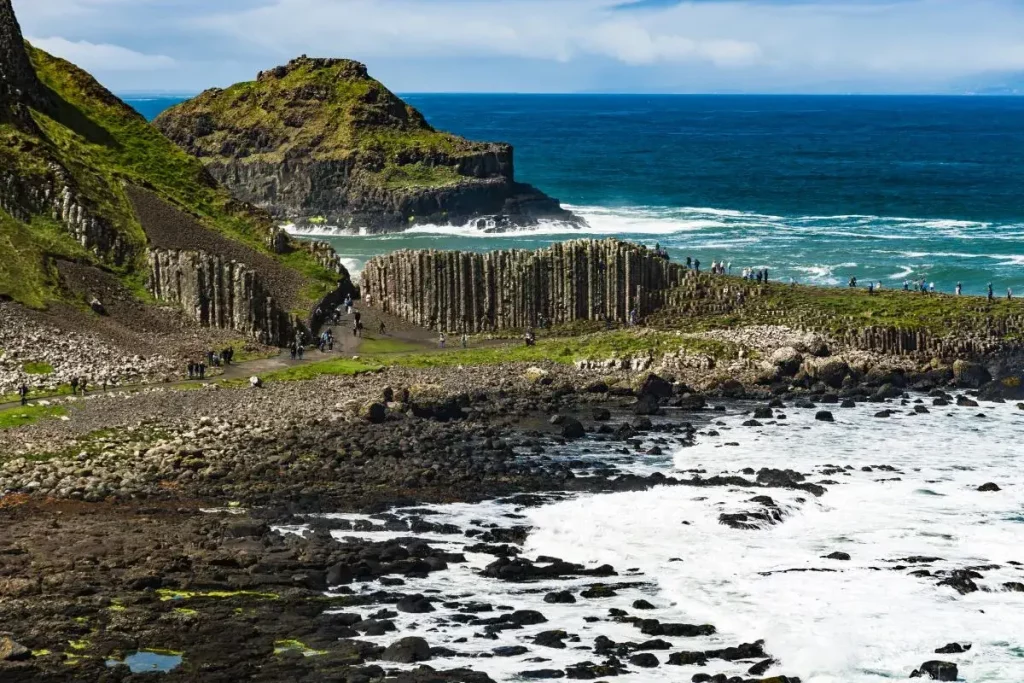
Giant’s Causeway, The Organ Pipes
The Pipe Organ is a rock formation located above Port Noffer, characterized by tall and straight columns that resemble organ pipes. It can be observed by following the path beyond the Causeway for a short distance.
The Grand Causeway includes the Wishing Well, Wishing Chair, and the Giant’s Gate, all of which are associated with the legend of Giant Macool.
From here, you can proceed to Port Noffer, which offers a contrasting environment characterized by its sheltered location. This area is known for its abundant bird species and vegetation.

Giant’s Causeway Boot
Visitors can climb the small slope from the Giants Boot to reach the Organ and admire the massive columns. Continuing along, they will come across the headland where the Amphitheatre, a viewing platform, is located. From this spot, one can enjoy the breathtaking landscapes of Antrim and take in the views of Rathlin Island and the North Atlantic.
Did you spot the Giant’s Harp and eyes?
By taking the time to climb the steep path with 162 steps, you can access the Shepherd’s Path that leads to the North Antrim Cliff Path. Within half a mile, you will arrive back at the Visitors Centre.
Best time to visit the Giant’s Causeway?
I enjoy visiting the Causeway during the spring and fall, as it attracts a good number tourists without being excessively crowded. Additionally, I appreciate the area during January and February despite the harsh weather conditions, as the sound and sight the Atlantic Ocean crashing against the rocks is captivating.
Conservation and Management of the Giant’s Causeway
The Giant’s Causeway is not only a world-famous attraction but also a protected area, carefully managed by the National Trust to preserve its unique natural and cultural heritage. The National Trust works tirelessly to safeguard the iconic rock formations, rare plants, and wildlife that make the causeway such a special place in Northern Ireland. Through ongoing conservation efforts, the Trust ensures that visitors can continue to enjoy the site for generations to come.
At the Giant’s Causeway Visitor Centre, you can learn more about the history, geology, and conservation of this UNESCO World Heritage Site. Interactive exhibits and educational displays highlight the importance of protecting the causeway from erosion and environmental threats. Visitors are encouraged to follow guidelines to help conserve the site, such as sticking to marked trails and respecting the natural environment. By supporting the National Trust and following best practices during your visit, you play a vital role in preserving one of Ireland’s most treasured landmarks.
Safety and Accessibility at the Giant’s Causeway
The Giant’s Causeway is committed to providing a safe and accessible experience for all visitors. The visitor centre offers mobility scooters and wheelchairs for those with limited mobility, and there are accessible paths and trails designed to ensure everyone can enjoy the beauty of the causeway. For added convenience, a regular shuttle bus service runs between the visitor centre and the causeway, making it easy to reach the famous rocks without a strenuous walk.
While exploring the site, visitors should take care on the rocks and trails, as surfaces can be uneven and slippery, especially in wet weather. It’s a good idea to wear sturdy shoes and dress in warm clothes, as the weather along the coast can change quickly. The Giant’s Causeway is a family-friendly destination, with guided tours, audio guides, and interactive exhibits available to enhance your visit. Whether you’re walking the trails, joining a tour, or simply taking in the views, the site’s facilities and staff are there to help make your visit safe, comfortable, and memorable.
Photography and Social Media Tips for the Giant’s Causeway
The Giant’s Causeway is a dream destination for photographers and social media enthusiasts alike. The striking basalt rock formations, dramatic coastline, and ever-changing light create endless opportunities for stunning photos. For the best shots, try visiting at sunrise or sunset, when the soft golden light brings out the textures and colours of the rocks and the Atlantic Ocean sparkles in the background.
Don’t forget to share your favourite moments on social media—use hashtags like #GiantsCauseway and #NorthernIreland to connect with other visitors and showcase your experience. Tagging the official Giant’s Causeway accounts is a great way to share your photos and stories with a wider audience. Whether you’re capturing sweeping landscapes, close-ups of the unique rocks, or candid moments with friends and family, the Giant’s Causeway offers endless inspiration for your next post. So charge your camera, plan your visit, and get ready to create memories that will last a lifetime in one of Ireland’s most photogenic locations.


4 thoughts on “Guide To The Giants Causeway Guide To The Giants Causeway”
Comments are closed.